Setting up your Spot-On Sundial Indoors
You can set-up your Spot-On Sundial in a conservatory or any room
indoors which gets a reasonable amount of sun. It is very easy to
set up the Spot-On Sundial for use indoors, and it does not need
to be fixed down permanently in position.
Before setting up your Spot-On Sundial, please read the pages on
"Finding the time of local noon" and
"Finding your latitude and longitude"
which you will need to set up your sundial accurately.
|
|
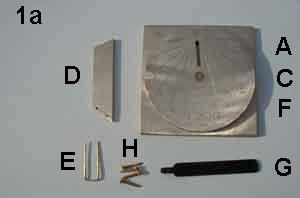
Unpack the box carefully and check the items listed are all present
- A, C and F - the circular dialplate (A) attached to the square
baseplate (C) with the centre screw (F)
- B - these instructions (not shown in picture)
- D - the gnomon made of two plates with a narrow air gap
- E - the gnomon retaining clip
- G - the tightening tool
- H - 4 brass screws for attaching the square baseplate to a plinth
or stand.
|
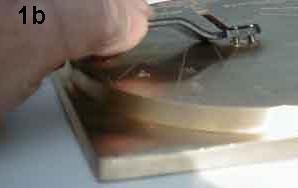
Place the two lugs on the tightening tool into the holes on the
centre screw, and rotate it anti-clockwise. (It helps to put your
other hand on the tightening tool above the centre screw to prevent
the lugs from disengaging). After a few turns, you will be able
to turn the centre screw by hand, remove it completely, and separate
the circular dialplate (B) from the square baseplate (A).
|
|
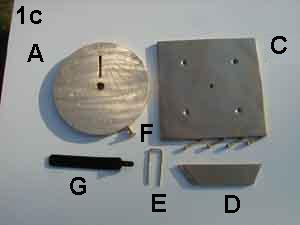
You now have the 6 components of the sundial and the 4 tightening
screws as shown in the illustration and identified by the letters
in panel 1c above.
If you have model E (San Francisco) , F (Los Angeles), or G (New
Orleans) you should place the centre screw back in the hole
in the centre of the dialplate, and secure it with a piece of tape
before proceeding to step 2. You need to do this because the low
angle of the gnomon on these models will not permit you to insert
the centre screw with the gnomon in place as described in step 6
|
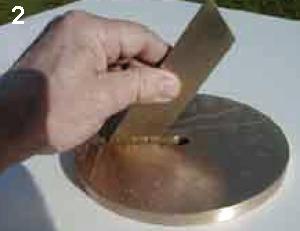
Hold the gnomon as shown and slide the thin end with the two holes
into the dialplate, so that it is slanting towards the centre as
shown. The gnomon is a tight fit in the dialplate, in order to ensure
it is at the correct angle. It is best to start with the acute angle,
and then "rock" the inner angle into position.
|
|
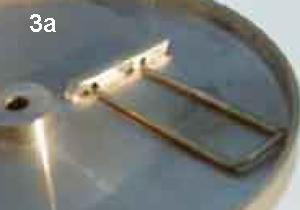
Turn the sundial over. The two holes in the gnomon should both be
clear of the baseplate. Position the gnomon retaining clip so that
the "arms" are flat on the baseplate, and the "hoop" is raised off
the baseplate as shown in panel 3a. Then slide the clip through
the two holes in the base of the gnomon.
|
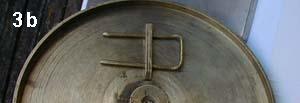
Push the gnomon retaining clip into the holes as far as is possible
by hand. (The arms are very slightly tapered to ensure a tight fit.)
|
|
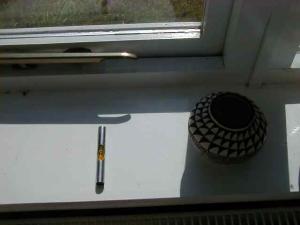
Select a suitable sunlit window sill or other flat surface. Window
sills are ideal because you do not need to screw the baseplate down
- you can locate it accurately just by pushing it tight up against
the window frame. That way, you can move it for cleaning the shelf,
and then just replace it tight against the window frame. In any
other position, it is best to screw it down to the surface - in
this case, you should follow the general setup
instructions.
Check that the window sill is completely level in 2 directions
at right angles to each other. It is worth taking trouble with this
since the accuracy of your sundial depends on it. (It is particularly
important to get it level in the east-west plane, since an error
of 1 degree in the level will lead to an error of 5 minutes or more
in the reading; an error of 1° in the north-south plane will only
result in an error of 2 minutes or so.)
If the window sill is not level, you should try to provide a shim
of brass or other suitable material to provide a level surface.
This is only critical if you want your sundial to read as accurately
as possible.
|
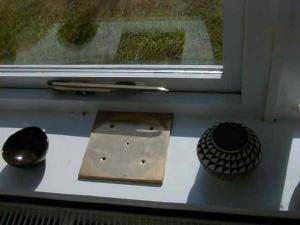
Place the baseplate in position on the window sill. If you want
to have it screwed down permanently in the same position, mark the
position of the screws on the window sill using a pencil through
the screw holes on the baseplate.
If you are certain that your plinth is level to within ½° and you
want to compensate for the small difference between the latitude
stamped on the dial and your actual latitude, so that you get the
maximum possible accuracy from your Spot-On Sundial, you should
read now our advanced setup page.
Place the dialplate on top of the baseplate, and line it up so
that the centre screw will pass through the dialplate and locate
in its correct position in the baseplate. Insert the centre screw
and tighten it by hand, leaving the dialplate free to rotate.
|
|
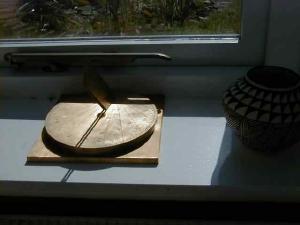
For the final stage of the setup
1. Set your watch accurately by a radio time signal.
2. Find out the time of solar noon at your
location using our unique Solar Noon Calculator.
3. When your watch reaches the exact time of Solar Noon, rotate
the dialplate until the shaft of sunlight shining through the slit
in the gnomon lies exactly along the dotted noon line. Then tighten
up the centre screw further with the aid of the tightening tool.
Your sundial is now set.
4. Please look at the pages on Reading the
Spot-On Sundial and on Looking after your
Spot-On Sundial if you have not already done so.
|
Enjoy your sundial as you lie back and relax!
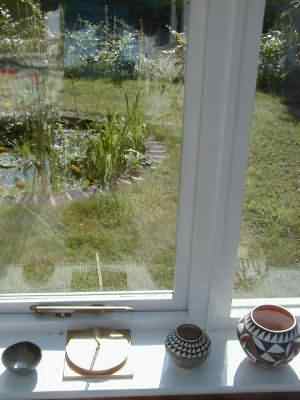
|